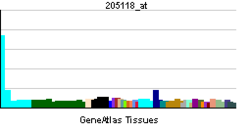Формил пептидни рецептор 1
| Формил пептидни рецептор 1 | |||
|---|---|---|---|
| Идентификатори | |||
| Симболи | ФПР1; ФМЛП; ФПР | ||
| Вањски ИД | ОМИМ: 136537 МГИ: 107443 ХомолоГене: 20466 ИУПХАР: ФПР1 ГенеЦардс: ФПР1 Гене | ||
| Преглед РНК изражавања | |||
 | |||
 | |||
| подаци | |||
| Ортолози | |||
| Врста | Човек | Миш | |
| Ентрез | 2357 | 14293 | |
| Енсембл | ЕНСГ00000171051 | ЕНСМУСГ00000045551 | |
| УниПрот | П21462 | Q3УВ01 | |
| РефСеq (мРНА) | НМ_002029 | НМ_013521 | |
| РефСеq (протеин) | НП_002020 | НП_038549 | |
| Локација (УЦСЦ) |
Цхр 19: 56.94 - 56.95 Мб |
Цхр 17: 17.58 - 17.59 Мб | |
| ПубМед претрага | [1] | [2] | |
fMet-Leu-Phe рецептор или N-формил пептидни рецептор је протеин који је код људи кодиран FPR1 геном.[1][2][3]
Види још[уреди | уреди извор]
Литература[уреди | уреди извор]
- ^ Боулаy Ф, Тардиф M, Броуцхон L, Вигнаис П (1990). „Сyнтхесис анд усе оф а новел Н-формyл пептиде деривативе то исолате а хуман Н-формyл пептиде рецептор цДНА”. Биоцхем Биопхyс Рес Цоммун. 168 (3): 1103—9. ПМИД 2161213. дои:10.1016/0006-291X(90)91143-Г.
- ^ Зханг Y, Сyед Р, Уyгар C, Паллос D, Горрy MC, Фиратли Е, Цортелли ЈР, ВанДyке ТЕ, Харт ПС, Феинголд Е, Харт ТЦ (2003). „Евалуатион оф хуман леукоцyте Н-формyлпептиде рецептор (ФПР1) СНПс ин аггрессиве периодонтитис патиентс”. Генес Иммун. 4 (1): 22—9. ПМИД 12595898. дои:10.1038/сј.гене.6363900.
- ^ „Ентрез Гене: ФПР1 формyл пептиде рецептор 1”.
Додатна литература[уреди | уреди извор]
- Гравес V; Габиг Т; МцЦартхy L; et al. (1992). „Simultaneous mobilization of Mac-1 (CD11b/CD18) and formyl peptide chemoattractant receptors in human neutrophils.”. Blood. 80 (3): 776—87. PMID 1322204.
- Murphy PM; Ozçelik T; Kenney RT; et al. (1992). „A structural homologue of the N-formyl peptide receptor. Characterization and chromosome mapping of a peptide chemoattractant receptor family.”. J. Biol. Chem. 267 (11): 7637—43. PMID 1373134.
- Perez HD; Holmes R; Kelly E; et al. (1992). „Cloning of the gene coding for a human receptor for formyl peptides. Characterization of a promoter region and evidence for polymorphic expression.”. Biochemistry. 31 (46): 11595—9. PMID 1445895. doi:10.1021/bi00161a044.
- Bao L; Gerard NP; Eddy RL; et al. (1992). „Mapping of genes for the human C5a receptor (C5AR), human FMLP receptor (FPR), and two FMLP receptor homologue orphan receptors (FPRH1, FPRH2) to chromosome 19.”. Genomics. 13 (2): 437—40. PMID 1612600. doi:10.1016/0888-7543(92)90265-T.
- Murphy PM, McDermott D (1991). „Functional expression of the human formyl peptide receptor in Xenopus oocytes requires a complementary human factor.”. J. Biol. Chem. 266 (19): 12560—7. PMID 1712023.
- Boulay F, Tardif M, Brouchon L, Vignais P (1991). „The human N-formylpeptide receptor. Characterization of two cDNA isolates and evidence for a new subfamily of G-protein-coupled receptors.”. Biochemistry. 29 (50): 11123—33. PMID 2176894. doi:10.1021/bi00502a016.
- Wahl SM; Allen JB; Gartner S; et al. (1989). „HIV-1 and its envelope glycoprotein down-regulate chemotactic ligand receptors and chemotactic function of peripheral blood monocytes.”. J. Immunol. 142 (10): 3553—9. PMID 2541200.
- Jesaitis AJ; Naemura JR; Painter RG; et al. (1983). „Intracellular localization of N-formyl chemotactic receptor and Mg2+ dependent ATPase in human granulocytes.”. Biochim. Biophys. Acta. 719 (3): 556—68. PMID 6129903.
- Prossnitz ER, Kim CM, Benovic JL, Ye RD (1995). „Phosphorylation of the N-formyl peptide receptor carboxyl terminus by the G protein-coupled receptor kinase, GRK2.”. J. Biol. Chem. 270 (3): 1130—7. PMID 7836371. doi:10.1074/jbc.270.3.1130.
- Klotz KN, Jesaitis AJ (1994). „Physical coupling of N-formyl peptide chemoattractant receptors to G protein is unaffected by desensitization.”. Biochem. Pharmacol. 48 (6): 1297—300. PMID 7945424. doi:10.1016/0006-2952(94)90168-6.
- Bommakanti RK, Dratz EA, Siemsen DW, Jesaitis AJ (1994). „Characterization of complex formation between Gi2 and octyl glucoside solubilized neutrophil N-formyl peptide chemoattractant receptor by sedimentation velocity.”. Biochim. Biophys. Acta. 1209 (1): 69—76. PMID 7947984. doi:10.1016/0167-4838(94)90138-4.
- Murphy PM, Tiffany HL, McDermott D, Ahuja SK (1993). „Sequence and organization of the human N-formyl peptide receptor-encoding gene.”. Gene. 133 (2): 285—90. PMID 8224916. doi:10.1016/0378-1119(93)90653-K.
- Jesaitis AJ; Erickson RW; Klotz KN; et al. (1993). „Functional molecular complexes of human N-formyl chemoattractant receptors and actin.”. J. Immunol. 151 (10): 5653—65. PMID 8228254.
- Särndahl E; Bokoch GM; Boulay F; et al. (1996). „Direct or C5a-induced activation of heterotrimeric Gi2 proteins in human neutrophils is associated with interaction between formyl peptide receptors and the cytoskeleton.”. J. Biol. Chem. 271 (25): 15267—71. PMID 8663057. doi:10.1074/jbc.271.25.15267.
- Maestes DC, Potter RM, Prossnitz ER (1999). „Differential phosphorylation paradigms dictate desensitization and internalization of the N-formyl peptide receptor.”. J. Biol. Chem. 274 (42): 29791—5. PMID 10514456. doi:10.1074/jbc.274.42.29791.
- Liang TS, Wang JM, Murphy PM, Gao JL (2000). „Serum amyloid A is a chemotactic agonist at FPR2, a low-affinity N-formylpeptide receptor on mouse neutrophils.”. Biochem. Biophys. Res. Commun. 270 (2): 331—5. PMID 10753626. doi:10.1006/bbrc.2000.2416.
- Luu NT, Rainger GE, Nash GB (2000). „Differential ability of exogenous chemotactic agents to disrupt transendothelial migration of flowing neutrophils.”. J. Immunol. 164 (11): 5961—9. PMID 10820279.
- Bennett TA, Maestas DC, Prossnitz ER (2000). „Arrestin binding to the G protein-coupled N-formyl peptide receptor is regulated by the conserved "DRY" sequence.”. J. Biol. Chem. 275 (32): 24590—4. PMID 10823817. doi:10.1074/jbc.C000314200.
- Ayala JM; Goyal S; Liverton NJ; et al. (2000). „Серум-индуцед моноцyте дифферентиатион анд моноцyте цхемотаxис аре регулатед бy тхе п38 МАП кинасе сигнал трансдуцтион патхwаy.”. Ј. Леукоц. Биол. 67 (6): 869—75. ПМИД 10857861.
